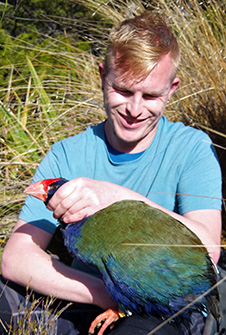Seventy-five years after they were rediscovered in Aotearoa, University of Otago-led research has sequenced ancient DNA of the takahē.
Marred by the impact of humans and past climatic change, the researchers hope the study will enable the past to inform the future by improving conservation management for the species.
Published in Molecular Ecology, the group used palaeogenetic techniques to sequence DNA from South Island takahē and moho (North Island takahē) remains to better understand their evolutionary history, prior to their respective major population bottleneck and extinction.

Dr Alex Verry.
The researchers found climate change following the end of the last Ice Age and onset of the current warm interglacial period may have led to the local extinction of takahē populations in the Nelson/Tasman region, but it was the arrival of humans to Aotearoa about 750 years ago which had the greatest impact.
Lead author Dr Alex Verry, of the Department of Zoology’s Palaeogenetics Laboratory, says the extinction of the moho and major loss of genetic diversity within takahē likely occurred by the time of European arrival.
“Takahē went from a large genetically diverse population to a small and in-bred one. The scale of the genetic bottleneck surprised us, with takahē left with little to no genetic variation,” he says.
“We know the bottleneck was large as the genetic lineage that characterises all historic and living takahē is not found in any of our archaeological or subfossil specimens.”
Co-author Dr Nic Rawlence, Director of Otago's Palaeogenetics Laboratory, says the research illustrates how new technologies and techniques can be used to inform our understanding of extinct species.

Dr Nic Rawlence.
“The fossil record can and should be used to determine the range of suitable habitats and potential translocation sites across the country, based on the preference of prehistoric takahē.
“The most important criterion for takahē habitat is, and will continue to be, predator control. However, the ideal habitat for the species is not the tussock that dominates their home today, rather the fossil record suggests that they preferred edge habitats such as the edges of forests, grasslands, and shrubland, where one habitat transitions into another,” he says.
The researchers also examined the whakapapa (family tree) of takahē. Previous research suggested takahē and moho were distantly related – the result of two separate colonisations of Aotearoa by pukeko-like ancestors.
“However, this study shows they descend from a single common ancestor which arrived in Aotearoa approximately four million years ago. The two takahē species subsequently evolved when the North and South Island landmasses joined around 1.5 million years ago,” Dr Rawlence says.
This year marks the 75th anniversary of the rediscovery of takahē by Dr Geoffrey Orbell in Takahē Valley in the Murchison Mountains above Te Anau.
Publication details:
Ancient mitochondrial genomes unveil the origins and evolutionary history of New Zealand’s enigmatic takahē and moho
Alexander J. F. Verry, Eduard Mas-Carrió, Gillian C. Gibb, Ludovic Dutoit, Bruce C. Robertson, Jonathan M. Waters, Nicolas J. Rawlence
Molecular Ecology
For more information, contact:
Dr Alex Verry
Otago Palaeogenetics Laboratory
Department of Zoology
University of Otago
Email verryalex94@gmail.com
Dr Nic Rawlence
Director, Otago Palaeogenetics Laboratory
Department of Zoology
University of Otago
Email nic.rawlence@otago.ac.nz
Ellie Rowley
Communications Adviser
University of Otago
Mob +64 21 278 8200
Email ellie.rowley@otago.ac.nz
